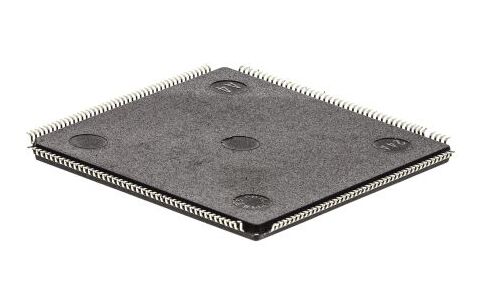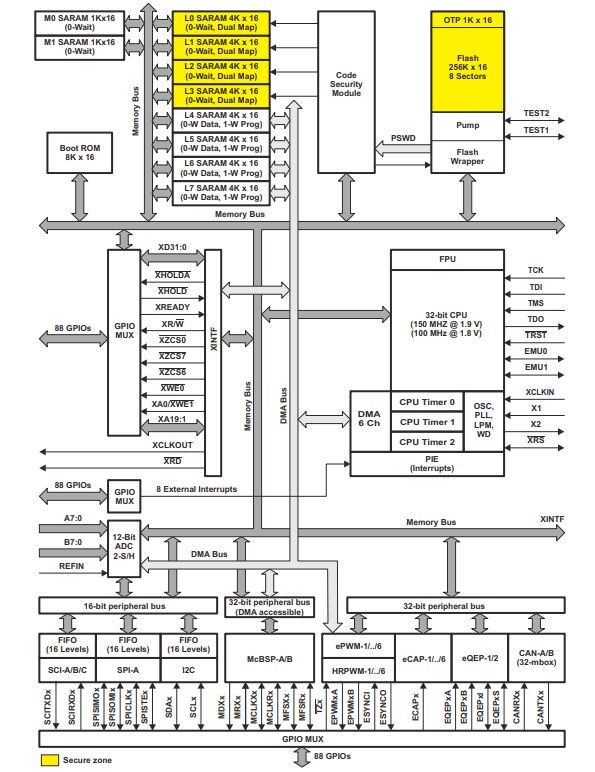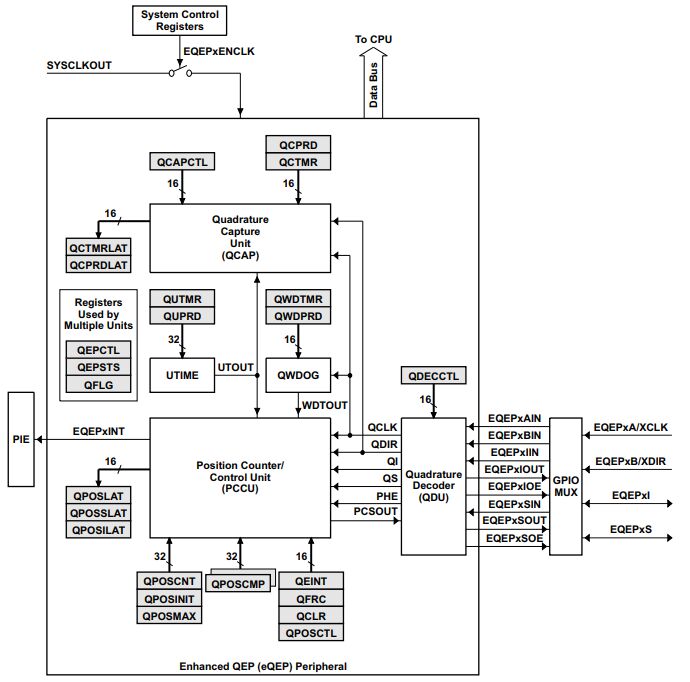By Texas Instruments 107
TMS320F28335PGFA is a 32-bit digital signal processor (DSP) launched by Texas Instruments. This DSP uses a high-performance 32-bit TMS320C28x DSP core, which has powerful mathematical operation capabilities and signal processing capabilities.
TMS320F28335PGFA has the characteristics of high performance, low power consumption and ease of use. It has a wide range of applications in the fields of real-time control and digital signal processing, especially in the fields of industrial control, automotive electronics, medical equipment and power electronics. It has powerful processing capabilities, rich peripheral interfaces, flexible communication functions and low power consumption characteristics, and is suitable for various real-time control and signal processing applications.

Ⅰ.Specification parameters of TMS320F28335PGFA
•Package:Tray
•Height:1.4 mm
•Length:24 mm
•Width:24 mm
•Product:DSCs
•Core:C28x
•Number of digits:32
•Number of pins:176
•Number of cores:1 Core
•Number of UARTs:3
•Maximum clock frequency:150 MHz
•Package/Case:LQFP-176
•Program memory size:512 kB
•Data RAM size:68 kB
•Operating power supply voltage:1.9 V
•Series:TMS320F28335
•Installation style:SMD/SMT
•Minimum operating temperature:-40℃
•Maximum operating temperature:+125℃
•ADC resolution:12 bit
•Data bus width:32 bit
•Humidity Sensitivity:Yes
•Analog-to-digital conversion number (ADC):1
•RAM size:34K x 16
•Number of input/output terminals:88 I/O
•REACH SVHC standard:No SVHC
•Instruction type:Floating Point
•Number of timers/counters:3 Timer
•Interface type:CAN/I2C/SCI/SPI/UART
•Power supply voltage-Minimum:1.805 V, 3.135 V
•Peripherals:DMA, POR, PWM, WDT
•Product categories:digital signal processors and controllers-DSP, DSC
•Product type:DSP-Digital Signal Processors & Controllers
Ⅱ.Main features of TMS320F28335PGFA
1.Memory:
•256KB of internal Flash memory for program storage
• 68KB of internal random access memory (RAM) for data storage and temporary calculations
2.IEEE 754 single-precision floating-point unit (FPU) (F2833x only)
3.Six-channel DMA controller (for ADC, McBSP, ePWM, XINTF and SARAM)
4.Analog input/output:
• Multiple input capture (eCAP) module for capturing external events and time measurements
•Built-in multi-channel 12-bit analog-to-digital converter (ADC) for analog signal acquisition and processing
5.Peripheral interface:
•Multiple timer modules for precise time control and periodic task processing
•Rich general-purpose input/output (GPIO) interfaces for external device connection and control
•A variety of serial communication interfaces (such as SPI, SCI, I2C, etc.) for data communication with external devices
•PWM (Pulse Width Modulation) module, supports high-precision PWM output, suitable for motor control and power conversion applications
6.Processing capacity:
•The operating frequency can be as high as 150MHz, providing high-performance data processing capabilities
•Uses a 32-bit fixed-point digital signal processor core to efficiently process digital signals
7.GPIO0 to GPIO63 pins can be connected to eight external core interrupts
8.TMS320F28335PGFA uses Texas Instruments’ second-generation DSP core, with a maximum frequency of 40MHz, which can provide high-speed digital signal processing capabilities
9.Peripheral Interrupt Extension (PIE) block supports all 58 peripheral interrupts
10.Three 32-bit CPU timers
Ⅲ.Application of TMS320F28335PGFA
1.Audio processing: TMS320F28335PGFA has high-speed digital signal processing capabilities and can be used in audio signal processing, decoding and compression. It is widely used in audio players and audio processing equipment. For audio processing applications, the more common DSP choices are those models focused on multimedia and audio processing, such as TI's TMS320DM series or other specialized audio DSPs. These DSPs usually have specialized audio processing instruction sets, hardware-accelerated audio codecs, higher sampling rates, and lower power consumption, making them more suitable for processing audio signals.
2.Motor control: TMS320F28335PGFA can provide efficient motor control algorithms, such as PID control, magnetic field oriented control, etc., and is widely used in motor drives, frequency converters and other fields. The advantages of TMS320F28335PGFA in motor control include: high-performance computing, rich peripheral interfaces, real-time control, reliability and stability, powerful control functions, etc.
3.Industrial control: TMS320F28335PGFA can be used in various industrial control systems, such as process control, position control, speed control, etc., to improve the accuracy and stability of the control system.
4.Robot: TMS320F28335PGFA can be used in the control system and signal processing of robots to achieve precise movement and perception control of robots.
5.Power electronics: TMS320F28335PGFA can be used in various power electronic converters, such as DC/DC converters, inverters and rectifiers, to achieve efficient power conversion and optimized control.
6.Aerospace: TMS320F28335PGFA is used in flight control systems, navigation systems, communication systems, etc., such as aircraft flight control, satellite navigation, avionics equipment, etc.
•In flight control systems, TMS320F28335PGFA can be used to execute complex control algorithms, such as attitude control, trajectory planning, flight dynamics modeling, etc. Its high-performance floating-point computing power and real-time performance can ensure the stability and safety of the aircraft under various flight conditions.
•In navigation systems, TMS320F28335PGFA can process data from inertial measurement units (IMU), global positioning systems (GPS), radio navigation systems and other sensors to achieve precise navigation and positioning. In addition, it can support advanced algorithms such as Kalman filters to fuse multi-source data and provide more accurate navigation information.
•In aerospace communication systems, TMS320F28335PGFA can be used to implement digital signal processing, modulation and demodulation, codec and other functions to support high-speed data transmission and reliable communication.
•In the aerospace industry, reliability and safety are critical. The TMS320F28335PGFA adopts an industrial-grade design and strict quality control processes to ensure that it can operate stably in extreme environments and meet strict safety standards in the aerospace field.
7.Military and national defense: TMS320F28335PGFA is used in military radar, missile control systems, tactical communications and other fields, such as military radar signal processing, missile guidance, communication encryption, etc. In the military and defense fields, security and reliability are of paramount importance. TMS320F28335PGFA adopts advanced security technology and strict quality control processes to ensure that it can operate stably in harsh environments and prevent malicious attacks or interference.
8.High-performance motor drive: This device is suitable for motor drive systems, such as DC motor drive, stepper motor control, etc. It enables high-speed, precise motor control and motion control algorithms.
Ⅳ.Development environment of TMS320F28335PGFA
1.Integrated development environment (IDE): Texas Instruments provides an integrated development environment called Code Composer Studio (CCS) for writing, compiling, debugging and deploying embedded software. CCS supports the development of TMS320 series processors and provides a wealth of tools and functions, including source code editors, compilers, debuggers, performance analyzers, etc.
2.Debugger: CCS provides a debugger for connecting to the target device, downloading the program, running the program and debugging the program.
3.Compiler: CCS integrates Texas Instruments' C language compiler, which is used to compile high-level language source code into machine code for the target processor.
4.Emulator: Texas Instruments provides a series of emulators and debuggers for connecting to the target processor for simulation and debugging. These emulators can be integrated with CCS to provide developers with real-time debugging and performance analysis capabilities.
Ⅴ.Functional Block Diagram of TMS320F28335PGFA

Ⅵ.Enhanced QEP Modules of TMS320F28335PGFA

Ⅶ.Programming method of TMS320F28335PGFA
1.Hardware structure: Familiarity with the hardware structure of TMS320F28335PGFA is a prerequisite for programming. You need to understand the pin definitions, internal memory and peripheral interfaces of the chip.
2.Instruction set: TMS320F28335PGFA supports a variety of instruction sets, including arithmetic operations, logical operations, data transmission, etc. During the programming process, these instruction sets need to be used flexibly to complete the implementation of the algorithm.
3.Programming language: TMS320F28335PGFA supports multiple programming languages, including assembly language, C language and C++ language, etc.
4.Development environment: In order to facilitate users to program and debug, Texas Instruments provides a variety of development environments for users to choose from, such as Code Composer Studio (CCS) development environment and TrueStudio development environment.
Frequently Asked Questions
1.What are the advantages and disadvantages of TMS320F28335PGFA compared with other similar chips?
Advantages: TMS320F28335PGFA has an operating frequency of up to 150MHz and powerful processing capabilities. It supports multiple low-power modes, which can reduce system power consumption and extend battery life.
Disadvantages: The TMS320F28335PGFA may be slightly more expensive than some competing products. The development and programming of MS320F28335PGFA requires a certain learning curve, especially for beginners, who need to spend some time to become familiar with its architecture and development tools.
2.How does TMS320F28335PGFA compare to other DSPs in terms of performance and features?
TMS320F28335PGFA offers competitive performance and a rich set of features compared to other DSPs in its class. It provides high processing power, versatile peripherals, and flexible communication interfaces.
3.What is the architecture of TMS320F28335PGFA?
The architecture of TMS320F28335PGFA is based on a 32-bit fixed-point DSP core operating at up to 150MHz. It includes various peripherals such as timers, PWM modules, communication interfaces, ADCs, and DMA controllers.